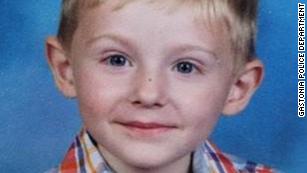By Darran Simon, CNN

(CNN) — The voice of a cartoon character. A favorite song. Messages from their parents.
When children with autism go missing, rescuers get to know their likes and dislikes, and use familiar sounds to draw them out during the search.
This week, authorities pumped pre-recorded messages from Maddox Scott Ritch's parents into the sprawling Rankin Lake Park in Gastonia, North Carolina -- the last place the 6-year-old boy was seen before he disappeared on Saturday.
Maddox has autism, a bio-neurological development disability that usually appears before the age of 3, and is nonverbal. Autism affects 1 in 59 children, according to the National Autism Association, and more than half are classified as having an intellectual disability or a borderline intellectual disability.
Kids with autism are often prone to wandering or bolting away -- Ian Ritch told reporters that he lost sight of his son when he took off running -- and searching for them is complicated by several factors, including their sensory issues and their likes and dislikes.
Experts said it's important to quickly develop a profile of a missing child to determine what techniques should be used to find them, and to be creative.
"Many of these children are more likely to respond to a favorite character, a unique interest or familiar voice," said Lori McIlwain, a co-founder of the National Autism Association. "It's imperative that first responders always talk to the parents to get a sense of what their particular likes and dislikes are. You could have one child that likes fire trucks and one that doesn't."
Seven years ago, searchers blasted one of young Joshua Robb's favorite tunes, Ozzy Osbourne's "No More Tears," in an effort find him after he disappeared into the San Bernardino National Forest in California. A rescue team heard some mumbling in the bushes and found the then-8-year-old 24 hours after he ran from his school.
"He was just standing there in a bush, no shirt, no shoes, just in his shorts and was very happy to be found," Justin Wheaton, one rescuer recalled in an interview with CNN at the time.

Maddox Scott Ritch
McIlwain, an association board member who has a teenage son with autism, said that kind of personalized approach has been successful.
In 2012, she worked with the National Center for Missing & Exploited Children to create federal search and rescue guidelines for missing children with special needs that law enforcement use. McIlwain said police officers have even played the voice of cartoon character Elmo in their search.
In some cases, rescuers have been too late.
In 2013, members of the New York City Police Department and other first responders combed the streets playing a recording of Avonte Oquendo's mother calling out to him. The 14-year-old, who was nonverbal like Maddox, was last seen on surveillance video running out of a school on Long Island City on the afternoon of October 4.
Police also deployed dogs, combed surveillance footage and repeatedly searched each of New York City's 468 subway stations because of Avonte's love of trains.
The teenager's remains were found three months later in the East River.
More than a decade ago, Brian Herritt, a California police officer whose son has severe autism, said he realized that other police departments didn't have the skills to deal with people with autism. So he started training them.
Now retired, Herritt said he teaches the first responders and other groups he trains to immediately develop a profile of the missing child, even during the initial call to dispatch. Herritt said time is critical because children with disabilities don't understand the danger they're in and gravitate to dangerous things, such as water or traffic.
The mortality risk for those with autism is twice as high as the general population, largely due to drowning and other accidents, according to the autism association."Six-year old kids don't go missing forever," said Herritt, who is not involved in the search for Maddox. "He's somewhere, they just have to continue to put resources to find him.""I'm sure every officer ... wants nothing more than to find this boy and reunite him with his family," he said. "As a cop, we protect people, and we protect people with special needs more because they need protection."































